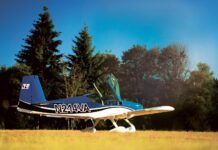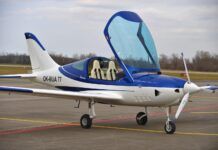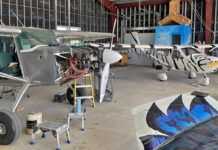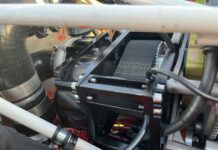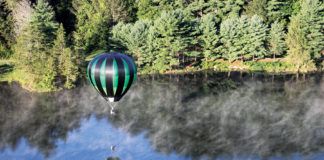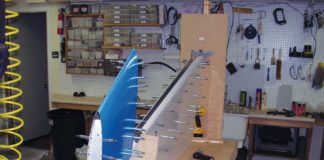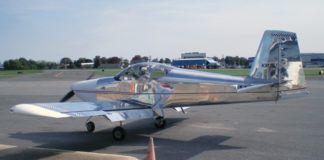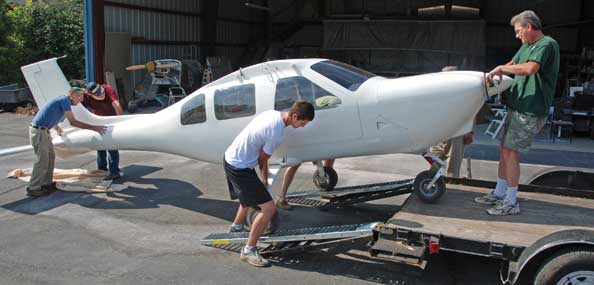
After two years of work and a lot of help, the Jabiru in the hangar behind the house was “ready to fly.” Next was the job of transporting it to a suitable runway. At 3100 feet, our runway is a bit short for first flight work, but more significantly, there are trees and mountainous terrain on all sides of it (go to www.01CL.com for a full description and photo). With the offer of hangar space, 6000 feet of runway with flat farmland all around at Lincoln Airport, a mere 30 crow-flies miles west, Horace Greeley’s words came to mind: “Go West, young man!”
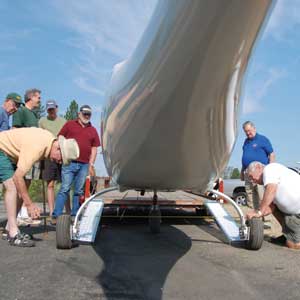
The axles were only about a half inch too long. Ironically, the author has a coffee cup in the shop that reads “Measure twice, cut once.” On the right are Dale Behymer and Floyd Bowen (Gene’s dad), and on the left are Jim McCormick, Gene Bowen, Beacham and Sanders.
Loading the Trailer
Getting there was not a four-word task. This phase started on Wednesday, August 12, 2009, so that there would be time for “Aw, nuts!” to intrude, and we would still be able to transport it all on the weekend. Allowing for the unanticipated became the sanity saver in this adventure. Frank Surfas was eager to offer his trailer inasmuch as it was with his truck and trailer that the boxes were transported the 150 miles from the warehouse to my hangar two years ago. It turns out, however, that the axles on the finished Jabiru protrude an inch more than the low walls of his trailer would allow. Buz Sanders immediately offered his new trailer that has no walls, but he noted that his truck had thrown a rod and was now an ex-truck, “Aw, nuts!” Jim Burkhalter came to the rescue when he offered his new truck. Luck came through again when we discovered that his truck had the precise fittings and hookups we needed. So with 10 people working, supervising and enjoying the commotion in a cooperative way, N2699T was moved onto the trailer, the wings placed on foam blocks underneath, and it was all tied down using the wing attach mounting points and a lot of mountaineering rope. The horizontal tail surfaces are not removable except with a saw, but the width luckily just touched the legally allowable limit.
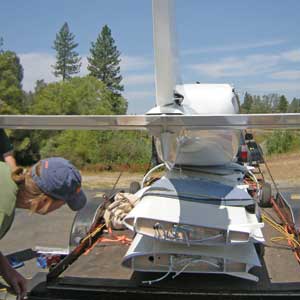
With the tanks emptied, flaps, elevator, rudder and ailerons in the station wagon, and a lot of foam, padding and tiedowns, the wings fit between the wheels as if planned!
The Long and Winding Road
Two days later we met at my hangar, Sanders loaded the control surfaces in his station wagon, and a convoy was arranged with Ethel and Dale Behymer in the lead, then the truck-trailer with Burkhalter, Gene Bowen and Mark Kirkpatrick next, my wife, Li, driving and me shooting photos, and finally Sanders in the station wagon with the flaps, et al. Surfas fired up his Nan Chang CJ6 and flew down, beating us all there, of course. Such is life at a rural fly-in community.
Ethel stayed about a quarter mile ahead, warning oncoming traffic of the load following. This was a good idea in that the first 10 miles are over a narrow mountain road with a 700-foot drop on one side and no rails. She told us later that she yelled and everyone heard her! For Li and me in the following car, it was fun watching the rubbernecks in the passing vehicles.
After three hours of careful driving, most of it on better roads, we were in front of the hangar at Lincoln. An hour later and all was unloaded; another couple of hours and the wings were back on. It’s amazing how quickly things will get done when you’re surrounded by cooperative competence.
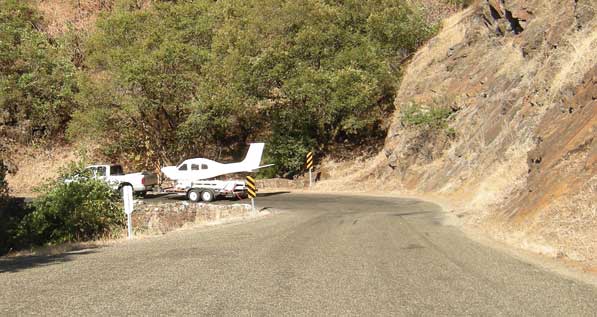
The trip involved 10 miles of narrow, winding mountain road with Ethel in the number one car warning the oncoming traffic.
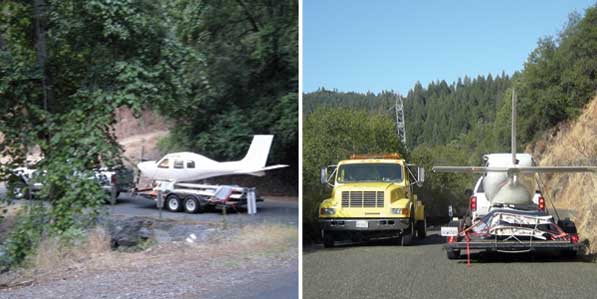
Left: Look up Mosquito Road in California to see why this is the easy road. The oncoming drivers had a good story to tell when they got home. Right: Here’s why Ethel was leading. This spot was negotiable, but had the vehicles met another 2 miles on, he’d have had a 700-foot drop and no rail.
The Second Final Assembly Begins
I had not anticipated the amount of work still to be done prior to the first flight. Ron Wright, who built his own Jabiru and owns the hangar at Lincoln, and Kirkpatrick, who scratch-designed and built his own four-place aircraft, started going over 99T. Although Kirkpatrick had done much of the completion work for me since my illness in January 2009, they still created a list of gotta-do’s. But after several days of hard work, the list was nil, and it looked like we would be ready for a planned first flight on the August 20.
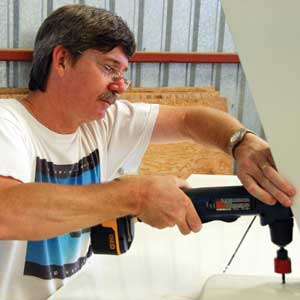
Mark Kirkpatrick double-checked the weight and balance, and then pulled off the Jabiru’s rudder to drill a large hole in the tail cone for adding ballast.
A number of friends and neighbors had asked to be with us for the first flight, but before saying “Y’all come,” I cleared it with the test pilot, Jim McCormick, of Jabiru Pacific. He had sold me the kit some two years ago and, as the most experienced Jabiru pilot I knew, he had accepted my request and would fly up from Fresno, 200 miles south. “Nobody in the hangar distracting me while I’m doing a preflight” was his only rule. No problem, was my reply. Some of our guests would have a three-hour drive prior to arriving at 0900, but all were admonished to stay away from the hangar.
A Nose Load to Do Cyrano Proud
With several days until first flight, Wright took 99T out for a first taxi test and found that “Aw, nuts!” had stowed away. First, he found that the elevator would not lift the nose off the ground, and as he increased speed, there was a terrible vibration coming from the tires.
The first clue as to the cause of the vibration was that the tread was not straight on the left tire; it went around the circumference nicely except for a 2-inch-long portion that looked like the markings on a politician’s lie detector test. McCormick flew up with two new tires the next day and then the wrenches flew. The cause of the joggle was found to be two 1-inch-long splits on the inside of the tire. The tubes looked fine, and there were no external indicators, so we chalked it up to a manufacturing defect and went to work getting the new tires on and testing them.
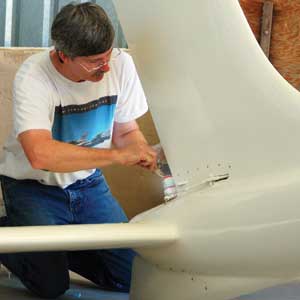
Kirkpatrick crawled inside and stuffed some foam in the gap between the leading edge of the horizontal stabilizer and the inside walls of the fuselage. With 99T sitting on its tail, the buckshot would stay confined as it hardened into a lump.
Getting the Weight In
The lack of authority in the elevator was a bit of a mystery. Looking for the obvious, we checked that it moved and had mechanical strength by simply having one person push down on the elevator while another pulled back on the stick; no problem. That led us to the next thing to check, the weight and balance. Another friend and neighbor, Steve Loree, was working nearby to get his one-of-a-kind biplane ready for first flight. As part of his aircraft welding business (Loree Air, 530/626-0691), Loree has a set of scales designed specifically for aircraft weight calculations. He brought them over, and we immediately found that the bathroom scales I’d previously used were inadequate. For years I had claimed they were lying every time I stood on them, so why I trusted them to weigh 99T eludes me.
Kirkpatrick cranked on the new numbers and generated a profile showing 99T was too nose-heavy. We could add 15 pounds of lead to the extreme end of the tail and put the aircraft just forward of middle of the safe range when flown with just Li at near empty fuel. This was originally designed as a four-place airplane with a smaller wing, so with the removal of the rear seats and the change to a wing with an 8-inch increase in chord, it proved to be very tolerant of loads in the rear. We tested his math first by placing sandbags on the horizontal stabilizer of Wright’s Jabiru to see how much was needed to lift the nosewheel off the floor, and then doing it with 99T. My Jabiru needed about 10 pounds more, but his Jabiru already has 7 pounds in the tail.
The big caution here is obvious, but I’ll say it anyway: Check your airplane weight with the proper type of scales and then get the balance calculations double-checked by an expert.
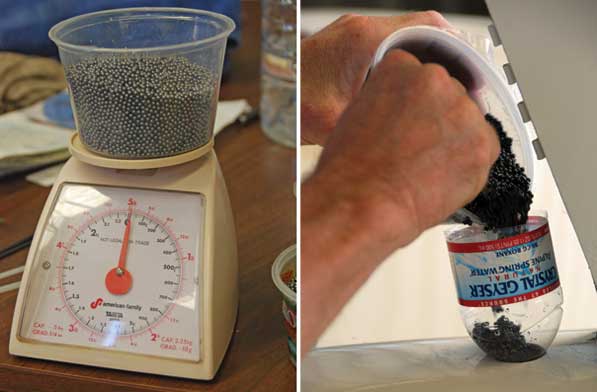
Left: Three of these cups of buckshot added up to 15 pounds of ballast in the tail. Right: Five pounds of buckshot mixed with a few ounces of two-part epoxy are easy to pour. The impromptu funnel worked better than hoped, and it was disposable after all 15 pounds were loaded.
High-Altitude Taxi Test
With Wright in the left seat and Kirkpatrick in the right, we all got a surprise: The high-speed taxi test turned into a “high-altitude” taxi test! As Kirkpatrick said later, “We were both watching the beautiful display [Grand Rapids] and realized that the ride had gotten very smooth at 41 knots, so we looked out and realized that we were off the ground!” The oft quoted advice is, “Just fly the plane,” so after 1000 feet of runway had passed, Wright pulled back on the nose handle and 99T settled to the runway from a maximum altitude of 6 feet. The GRT display is that gorgeous.
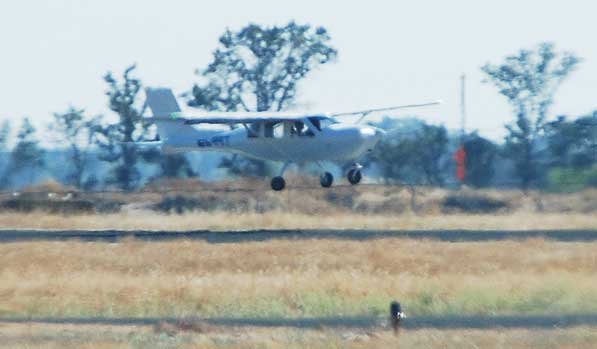
Not a first flight, just a high-altitude taxi test. At 40 knots and with no elevator, the plane is off the ground. That’s the reason for choosing a long runway with farmland and few trees.
This illustrates the wisdom of having so many eyes spending so much time going over the aircraft prior to the taxi test and selecting an extra-long runway. Many a taxi test has morphed into a first and last flight into the trees at the end of the runway. [And it’s why many experienced test pilots really don’t like to perform high-speed taxi tests.—Ed.]
But was this a first flight? I think not. I opined that without a 360° turn, it’s not the genuine article. That earned the comeback that the Wright brothers must not have really had a first flight in 1903. Well, my airplane, my definition, so after a much slower taxi to the hangar we discussed how and when to make the actual first flight now that all of the “Aw, nuts!” had been 86’d—or so we hoped. Stay tuned!
For more information on the Jabiru J250, call 559/431-1701, or visit www.jabirupacific.com.




